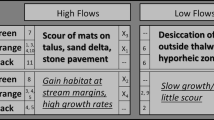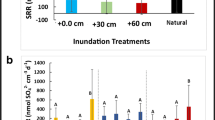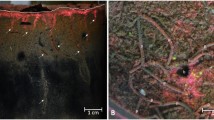Abstract
Lotic methane production, consumption, and flux depends on biogeochemical conditions that vary at fine scales within streams. The invasive bivalve, Corbicula fluminea, is known to affect stream biogeochemistry and may influence methane cycling via bioturbation and respiration. Response of methanogenesis rate, potential rate of methanotrophy, and net methane flux to Corbicula density was tested using intact sediment core incubations. Potential methanotrophy decreased and net methane flux increased with Corbicula density in sediment cores. However, the magnitude of this effect decreased at the highest Corbicula densities tested here. Response of sediment pore water methane concentration to Corbicula density was tested using in situ cage enclosures in a randomized block design over a 50 m stream reach. Block effect was the most significant predictor of in situ pore water methane concentration, and Corbicula density had a positive, marginally significant, interaction with the block effect, indicating that Corbicula’s effect on methane concentration varies with in situ conditions. Our study shows that Corbicula influences methane cycling processes in the laboratory, apparently via their impact on dissolved oxygen, but this effect depends on stream conditions in the field. Further study is needed to evaluate mechanisms of this relationship more fully.





Similar content being viewed by others
Abbreviations
- AFDM:
-
Ash free dry mass
- AIC:
-
Akaike information criteria
- DO:
-
Dissolved oxygen
- DTR:
-
Depth to refusal
- GC-FID:
-
Gas chromatography with flame ionization detection
- GLS:
-
Generalized least squares regression
- OLS:
-
Ordinary least squares regression
References
Atkinson CL, Opsahl SP, Covich AP, Golladay SW, Conner LM (2010) Stable isotopic signatures, tissue stoichiometry, and nutrient cycling (C and N) of native and invasive freshwater bivalves. J N Am Benthol Soc 29:496–505
Atkinson CL, Capps KA, Rugenski AT, Vanni MJ (2017) Consumer-driven nutrient dynamics in freshwater ecosystems: from individuals to ecosystems. Biol Rev 92:2003–2023
Bastviken D, Cole J, Pace M, Tranvik L (2004) Methane emissions from lakes: dependence of lake characteristics, two regional assessments, and a global estimate. Global Biogeochem Cycles 18:GB4009. https://doi.org/10.1029/2004gb002238
Bastviken D, Tranvik LJ, Downing JA, Crill PM, Enrich-Prast A (2011) Freshwater methane emissions offset the continental carbon sink. Science 331:50
Belanger SE (1991) The effect of dissolved oxygen, sediment, and sewage treatment plant discharges upon growth, survival and density of Asiatic clams. Hydrobiologia 218:113–126
Benelli S, Bartoli M, Racchetti E, Moraes PC, Zilius M, Lubiene I, Fano EA (2017) Rare but large bivalves alter benthic respiration and nutrient recycling in riverine sediments. Aquat Ecol 51:1–16
Bernhardt ES, Heffernan JB, Grimm NB, Stanley EH, Harvey JW, Arroita M, Appling AP, Cohen MJ, McDowell WH, Hall RO Jr, Read JS, Roberts BJ, Stets EG, Yackulic CB (2017) The metabolic regimes of flowing waters. Limnol Oceanogr. https://doi.org/10.1002/lno.10726
Brown JH, Gillooly JK, Allen AP, Savage VM, West GB (2004) Toward a metabolic theory of ecology. Ecology 85:1771–1789
Bullard AE (2010) Impact of Corbicula fluminae (Asian clams) on particulate matter transport in an urban stream. Master’s Thesis, University of North Carolina at Greensboro
Bullard AE, Hershey AE (2013) Impact of Corbicula fluminea (Asian clam) on seston in an urban stream receiving wastewater effluent. Freshw Sci 32:976–990
Cole JJ, Prairie YT, Caraco NF, McDowell WH, Tranvik LJ, Striegl RG, Duarte CM, Kortelainen P, Downing JA, Middelburg JJ, Melack J (2007) Plumbing the global carbon cycle: integrating inland waters into the terrestrial carbon budget. Ecosystems 10:171–184
Conrad R (2009) The global methane cycle: recent advances in understanding the microbial processes involved. Environ Microbiol Rep 1:285–292
Crawford JT, Stanley EH (2016) Controls on methane concentrations and fluxes in streams draining human-dominated landscapes. Ecol Appl 26:1581–1591
Crawford JT, Loken LC, West WE, Crary B, Spawn SA, Gubbins N, Jones SE, Striegl Stanley EH (2017) Spatial heterogeneity of within-stream methane concentrations. J Geophys Res: Biogeosci 122:1036–1048
Crespo D, Dolbeth M, Leston S, Sousa R, Pardal MA (2015) Distribution of Corbicula fluminea (Muller, 1774) in the invaded range: a geographic approach with notes on species traits variability. Biol Invasions 17:2087–2101
Ferreira-Rodriguez N, Sousa R, Pardo I (2016) Negative effects of Corbicula fluminea over native freshwater mussels. Hydrobiologia https://www.researchgate.net/publication/310817249
Frenzel P, Bosse U (1996) Methyl fluoride, an inhibitor of methane oxidation and methane production. FEMS Microbiol Ecol 2:25–36
Hakenkamp CC, Palmer MA (1999) Introduced bivalves in freshwater ecosystems: the impact of Corbicula on organic matter dynamics in a sandy stream. Oecologia 119:445–451
Hakenkamp CC, Ribblett SG, Palmer MA, Swan CM, Reid JW, Goodison MR (2001) The impact of an introduced bivalve (Corbicula fluminea) on the benthos of a sandy stream. Freshw Biol 46:491–501
Hershey AE, Northington RM, Hart-Smith J, Bostick M, Whalen SC (2015) Methane efflux and oxidation, and use of methane derived carbon by larval Chironomini, in arctic lake sediments. Limnol Oceanogr. https://doi.org/10.1002/lno.10023
Hoellein TJ, Zarnoch CB, Bruesewitz DA, DeMartini J (2017) Contributions of freshwater mussels (Unionidae) to nutrient cycling in an urban river: filtration, recycling, storage, and removal. Biogeochemistry 135:307–324
Holmes RM, Fisher SC, Grimm NB (1994) Parafluvial nitrogen dynamics in a desert stream ecosystem. J N Am Bentholog Soc 13:468–478
Jones RI, Grey J (2011) Biogenic methane in freshwater food webs. Freshw Biol 56:213–229
Jones JB, Mulholland PJ (1998a) Methane input and evasion in a hardwood forest stream: effects of subsurface flow from shallow and deep pathways. Limnol Oceanogr 43:1243–1250
Jones JB, Mulholland PJ (1998b) Influence of drainage basin topography and elevation on carbon dioxide and methane supersaturation of stream water. Biogeochemistry 40:57–72
Krause S, Hannah DM, Fleckenstein JH, Heppell CM, Kaesar D, Pickup R, Pinay G, Robertson AL, Wood PJ (2011) Interdisciplinary perspectives on processes in the hyporheic zone. Ecohydrology 4:481–499
Lofton DD, Whalen SC, Hershey AE (2014) Effect of temperature on methane dynamics and evaluation of methane oxidation kinetics in shallow Arctic Alaskan lakes. Hydrobiologia 721:209–222
Majdi N, Bardon L, Gilbert F (2014) Quantification of sediment reworking by the Asiatic clam Corbicula fluminea Muller, 1774. Hydrobiologia 732:85–92
Novais A, Souza AT, Ilarri M, Pascoal C, Sousa R (2016) Effects of the invasive clam Corbicula fluminea (Müller, 1774) on an estuarine microbial community. Sci Total Environ 556–557:1168–1175
Pereira JL, Vidal T, Mendes C, Re A, Santos JI, Goncalves F, Castro BB (2017) Invasive Asian clam distribution pattern reveals minimal constraints to downstream dispersal, and imperceptible ecological impacts. Aquat Conserv Mar Freshw Ecosyst 27:953–964
Pickett STA, Cadenasso ML, Rosi-Marshall EJ, Belt KT, Groffman PM, Grove JM, Irwin EG, Kaushal SS, LaDeau SL, Nilon CH, Swan CM, Warren PS (2017) Urban Ecosyst 20:1–14
Pigneur LM, Falisse E, Roland K, Everbecq E, Deliege JF, Smitz JS, Van Doninck K, Descy JP (2014) Impact of invasive Asian clams, Corbicula spp., on a large river ecosystem. Freshw Biol 59:573–583
Pinheiro J, Bates D, DebRoy S, Sarkar D, R Core Team (2018) nlme: Linear and Nonlinear Mixed Effects Models. R package version 3.1-137, https://CRAN.R-project.org/package=nlme
Pou-Rovira Q, Araujo R, Boix D, Clavero M, Feo C, Ordeix M, Zamora L (2009) Presence of the alien Chinese pond mussel Anodonta woodiana (Lea, 1834) (Bivalvia, Unionidae) in the Iberian Peninsula. Graellsia 65:67–70
Prezant RS, Chalermwat K (1984) Flotation of the bivalve Corbicula fluminea as a means of dispersal. Science 225:1491–1493
R Core Team (2017) R: A Language and Environment for Statistical Computing. https://www.R-project.org/
Seeberg-Elverfeldt J, Schluter M, Feseker T, Kolling M (2005) Rhizon sampling of porewaters near the sediment-water interface of aquatic ecosystems. Limnol Oceanogr: Methods 3:361–371
Segers R (1998) Methane production and methane consumption: a review of processes underlying wetland methane fluxes. Biogeochemistry 41:23–51
Shelley F, Abdullahi F, Grey J, Trimmer M (2015) Microbial methane cycling in the bed of a chalk river: oxidation has the potential to match methanogenesis enhanced by warming. Freshw Biol 60:150–160
Smith MK (2013) Methanogens and Methane Oxidizing Bacteria in Forested, Urban Unrestored, and Urban Restored Streams. Master’s Thesis. The University of North Carolina at Greensboro
Smith R, Kushal SS, Beaulieu JJ, Pennino MJ, Welty C (2017) Influence of infrastructure on water quality and greenhouse gas dynamics in urban streams. Biogeosciences 14:2831–2849
Sousa R, Antunes C, Guilhermino L (2008a) Ecology of the invasive Asian clam Corbicula fluminea (Muller, 1774) in aquatic ecosystems: an overview. Ann Limnol 44:85–94
Sousa R, Nogueira AJA, Gaspar MB, Antunes C, Guilhermino L (2008b) Growth and extremely high production of the non-indigenous invasive species Corbicula fluminea (Muller, 1774): possible implications for ecosystem functioning. Estuar Coast Shelf Sci 80:289–295
Sousa R, Rufino M, Gaspar M, Antunes C, Guilhermino L (2008c) Abiotic impacts on spatial and temporal distribution of Corbicula fluminea (Muller, 1774) in the River Minho Estuary, Portugal. Aquat Conserv: Mar Freshw Ecosyst 18:98–110
Sousa R, Gutierrez JL, Aldridge DC (2009) Non-indigenous invasive bivalves as ecosystem engineers. Biol Invasions 11:2367–2385
Sousa R, Morais P, Dias E, Antunes C (2011) Biological invasions and ecosystem functioning: time to merge. Biol Invasions 13:1055–1058
Sousa R, Novais A, Costa R, Strayer DL (2014) Invasive bivalves in freshwaters: impacts from individuals to ecosystems and possible control strategies. Hydrobiologia 735:233–251
Stanley EH, Casson NJ, Christel ST, Crawford JT, Loken LC, Oliver SK (2016) The ecology of methane in streams and rivers: patterns, controls, and global significance. Ecol Monogr 86:146–171
Strayer DL (1999) Effects of alien species on freshwater mollusks in North America. J N Am Bentholog Soc 18:74–98
Striegl RG, Dornblaser MM, McDonald CP, Rover JR, Stets EG (2012) Carbon dioxide and methane emissions from the Yukon River System. Global Biogeochem Cycles. https://doi.org/10.1029/2012gb004306
Trimmer M, Hildrew AG, Jackson MC, Pretty JL, Grey J (2009) Evidence for the role of methane-derived carbon in a free-flowing, lowland river food web. Limnol Oceanogr 54:1541–1547
Trimmer M, Grey J, Heppell CM, Hildrew AG, Lansdown K, Stahl H, Yvon-Durocher G (2012) River bed carbon and nitrogen cycling: state of play and some new directions. Sci Total Environ 434:143–158
Trimmer M, Shelley FC, Purdy KJ, Maanoja ST, Chronopoulou PM, Grey J (2015) Riverbed methanotrophy sustained by high carbon conversion efficiency. ISME J 9:2304–2314
Turek KA, Hoellein TJ (2015) The invasive Asian clam (Corbicula fluminea) increases sediment denitrification and ammonium flux in 2 streams in the midwestern USA. Freshw Sci 34:472–484
United States Geological Survey (2019) Current Conditions for North Carolina: Streamflow. https://waterdata.usgs.gov/nc/nwis/current/?type=flow&group_key=basin_cd
Vaughn CC (2010) Biodiversity losses and ecosystem function in freshwaters: emerging conclusions and research directions. Bioscience 60:25–35
Vaughn CC, Hakenkamp CC (2001) The functional role of burrowing bivalves in freshwater ecosystems. Freshw Biol 46:1431–1446
Vitousek PM (1990) Biological invasions and ecosystem processes: towards an integration of population biology and ecosystem studies. Oikos 57:7–13
Walsh CJ, Roy AH, Feminella JW, Cottingham PD, Groffman PM, Morgan RP II (2005) The urban stream syndrome: current knowledge and search for a cure. J N Am Bentholog Soc 24:706–723
Whalen SC (2005) Biogeochemistry of methane exchange between natural wetlands and the atmosphere. Environ Sci Eng 22:73–94
Wickham H (2016) ggplot2: Elegant Graphics for Data Analysis. Springer-Verlag, New York
Yamamoto S, Alcauskas JB, Crozier TE (1976) Solubility of methane in distilled water and seawater. J Chem Eng Data 21:78–80
Zarnetske JP, Haggerty R, Wondzell SM, Baker MA (2011) Dynamics of nitrate production and removal as a function of residence time in the hyporheic zone. J Geophys Res. https://doi.org/10.1029/2010jg001356
Zhang L, Shen Q, Hu H, Shao S, Fan C (2011) Impacts of corbicula fluminea on oxygen uptake and nutrient fluxes across the sediment-water interface. Water Air Soil Pollut 20:399–411
Zhang L, Liao Q, Wei HE, Shang J, Fan C (2013) The effects of temperature on oxygen uptake and nutrient flux in sediment inhabited by molluscs. J Limnol 72:13–20
Zuur AF, Ieno EN, Walker NJ, Saveliev AA, Smith GM (2009) Limitations of linear Regression applied on ecological data. Mixed effects models and extensions in ecology with R. Springer, LLC, New York
Acknowledgements
Methane analysis was conducted at UNC Chapel Hill with guidance and technical expertise provided by Dr. Steve Whalen and his graduate student, Katy Broadwater. Thanks to members of the Hershey lab who provided support for both laboratory and field experiments and thanks to Peter Blum for aiding with methane conversions. We would also like to thank two anonymous reviewers whose comments helped improve the manuscript. Funding was provided by the UNC Greensboro Biology Department, the W. John O’Brien Award for Field Research, and the Julia Taylor Morton Endowment.
Author information
Authors and Affiliations
Corresponding author
Ethics declarations
Conflict of interest
The authors declare that they have no conflict of interests.
Additional information
Publisher's Note
Springer Nature remains neutral with regard to jurisdictional claims in published maps and institutional affiliations.
Responsible Editor: Jennifer Leah Tank.
Rights and permissions
About this article
Cite this article
Brown, R.S., Hershey, A.E. Potential effects of the invasive bivalve Corbicula fluminea on methane cycling processes in an urban stream. Biogeochemistry 144, 181–195 (2019). https://doi.org/10.1007/s10533-019-00578-1
Received:
Accepted:
Published:
Issue Date:
DOI: https://doi.org/10.1007/s10533-019-00578-1




